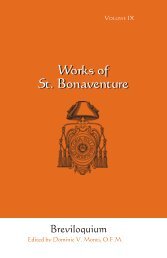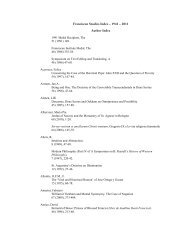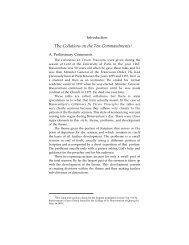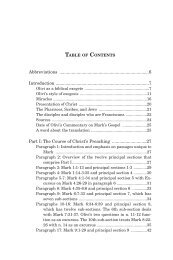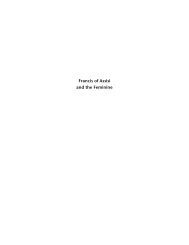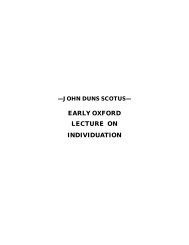FOUR QUESTIONS ON MARY - Franciscan Institute Publications
FOUR QUESTIONS ON MARY - Franciscan Institute Publications
FOUR QUESTIONS ON MARY - Franciscan Institute Publications
You also want an ePaper? Increase the reach of your titles
YUMPU automatically turns print PDFs into web optimized ePapers that Google loves.
John Duns Scotus: Four Questions on Mary<br />
the moment of his conception.” 25 Hence, he concludes, 26 there<br />
is no will, and consequently no question of either sin or sanctification.<br />
If the moment of animation marks the “conception<br />
as regards the world,” Henry explained, then the moment<br />
the soul is sanctified may be called a “conception as regards<br />
God.” Basing his computations on the date of Mary’s birthday<br />
(September 8), Henry points out that December the 8th,<br />
the day the Normans celebrate the feast, must be the conceptio<br />
nudi seminis (the conception of the bare seed). Since there<br />
is nothing sacred about this biological event, “conception” in<br />
this sense cannot be precisely what is being commemorated.<br />
“If they celebrate this day ‘by reason of conception,’ it must<br />
be some other sort of conception they have in mind,” 27 namely,<br />
the date of animation by the rational soul on Jan. 11 when<br />
her soul was created and infused in her body. This moment<br />
could be also called her nativity within the womb. 28 But inasmuch<br />
as the seminally conceived flesh has this qualitas<br />
morbida, the soul in contacting it contracts original sin automatically<br />
as it were. But once sin is present, sanctification,<br />
by definition, 29 becomes possible.<br />
Since sanctification is what is being celebrated, the real<br />
question the inquirer who posed it wants answered, there-<br />
25 Anselm, De conceptu virginali et de originali peccato, c. 7, (ed.<br />
Schmitt, vol. II, 148): Quod autem mox ab ipsa conceptione rationalem animam<br />
habeat, nullus humanus suscipit sensus. Henry agrees with Anselm;<br />
see note 21 supra.<br />
26 Ibid.: [Ergo] in eo non est peccatum originale mox cum conceptus est.<br />
27 Henry, op. cit., fol. 585r [T]: Sed si celebrant illud ratione conceptionis,<br />
debent intendere quod rationis alicuius alterius conceptionis, ut iam<br />
videbitur.<br />
28 Ibid. [V]: Si ergo loquamur de ista conceptione virginis qua concepta<br />
est homo perfectus 11 die Ianuarii, scilicet 3 Idus Ianuarii, qua concepta<br />
fuit eius nativitas in utero.<br />
29 Sanctification has a technical meaning, as Alexander of Hales explains:<br />
Dicimus quod sanctificatio secundum quod communiter vel generaliter<br />
accipitur, prout scilicet communiter est in omnibus sanctificatis, est<br />
mundatio ab originale culpa, nec plus habet sanctifiatio de ratione sua<br />
communi quam huiusmodi mundationem. Quaestio de sanctificatione (Codex<br />
Vat. lat. 782, fol. 60c; see also Thomas Aquinas, Summa theol. III, q.<br />
27, art. 2: “The sanctification of the Blessed Virgin cannot be understood as<br />
having taken place before animation ... because the sanctification of which<br />
we are speaking is nothing but the cleansing from original sin.” (ed. cit.,<br />
vol. II, 2164).<br />
10



